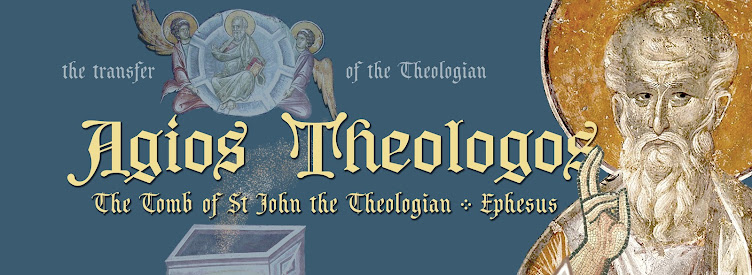 |
| “The Metastasis (Translation) of St John the Theologian” Fresco. Mount Athos, Dionysiou Monastery XVI c. |
As his hagiography recounts, St John the Theologian’s life, nearly half of which he spent in Ephesus (43 years in total including the time before and after his exile on Patmos), ended mysteriously. It is said that St John went out of Ephesus, taking seven of his disciples with him to a nearby hill, which according to tradition was his favorite place. Here he often went by himself to pray, and it was on the top of this hill that he wrote his Gospel. There he ordered his disciples to dig him a cross-shaped grave and to bury him alive.
The habit of frequent climbing on a mountain for prayer in solitude was one which St John adopted from his beloved Teacher (Mt. 14:23, Mk. 6:46, Lk. 6:12, Jn. 6:15), Whom he imitated in everything. “My children, he that saith he abideth in him ought himself also so to walk, even as He walked” (1 John 2:6). Retreat into solitude is also an evangelical command: “Enter into thy closet” (Mt 6:6). In other words, one should prayerfully enter into one’s soul in the company of God alone. For according to patristic tradition, prayerful solitude and silence cleanse, pacify, enlighten and strengthen man.
When the other Christians from Ephesus heard that their spiritual father had reposed, they were grieved that they had not bid farewell to their beloved teacher. They came and dug up the grave, but they did not find the body of St John. Every year, on the eight of May, as a comfort to his disciples, and later for all Christians, a miraculous dust, fragrant and healing, came out of his tomb. Through the prayers of Saint John this dust granted healing and spiritual comfort to all who encountered it. This holy dust was called “manna.”
The Akathist to St. John describes this miracle thus: “The grace which was given from God to this place where thy body was laid to earth, on the day of thy burial caused a fine dust to come forth from it for the healing of the ailing…” (12 Kontakion)
Since that time St. John’s grave became a great place of veneration not just for the Christians of Ephesus and Asia Minor but for the entire Christian world. During the 2nd to 3rd century a small church was built, a martyrium. Then in the fourth century the holy Byzantine Emperor Theodosius I the Great erected a basilica (75 x 44m ) over this site, but an earthquake damaged it severely during the fifth century.
Afterwards, in the 6th century, the greatest Byzantine Emperor-builder Justinian I (whom some consider to be a Slav in origin named Upravda) built there a much larger basilica (130 x 65m) which in its beauty and grandeur was rivalled only by the same emperor’s pearls of Constantinople, the churches of Hagia Sophia and the Holy Apostles (see under “Basilica” tab).
 |
| Bishop Akakije and nuns at prayer before the tomb of St John the Theologian |
The grave of St John lies in a crypt beneath the altar. Following the model of early Christian basilicae, the altar and holy table are in the middle of the church, that is, in the middle of the cross, at the place where the nave and the transept meet under the main cupola. In this arrangement, the chancel is situated in the eastern apse.
Today, above the tomb stands a square raised marble platform, a sort of reconstruction of the altar. Each corner bears a marble pillar, making the entire structure reminiscent of a ciborium, a marble canopy over the holy table. Striking out from the altar are the clear remains of a Byzantine marble ambo, stretching deep into the nave of the church from the royal doors.
There is also a reconstructed marble iconostasis, constructed of marble pillars on which are joined partially authentic architrave marble beams from the Justinian period. On these architrave beams one can see fragments of old Greek carved into the stone, psalm verses which are St John’s mystical epitaph:
“This is my resting place for ever and ever; here will I sit enthroned, for I have desired it. I will bless her with abundant provisions, her poor will I satisfy with food. I will clothe her priests with salvation, and her faithful people will ever sing for joy…” (Ps. 130/131:14-16)This epitaph was the motto of the original martyrium (mausoleum) from the 2nd century, which both Theodosius’ and Justinian’s basilicae inherited.

No comments:
Post a Comment